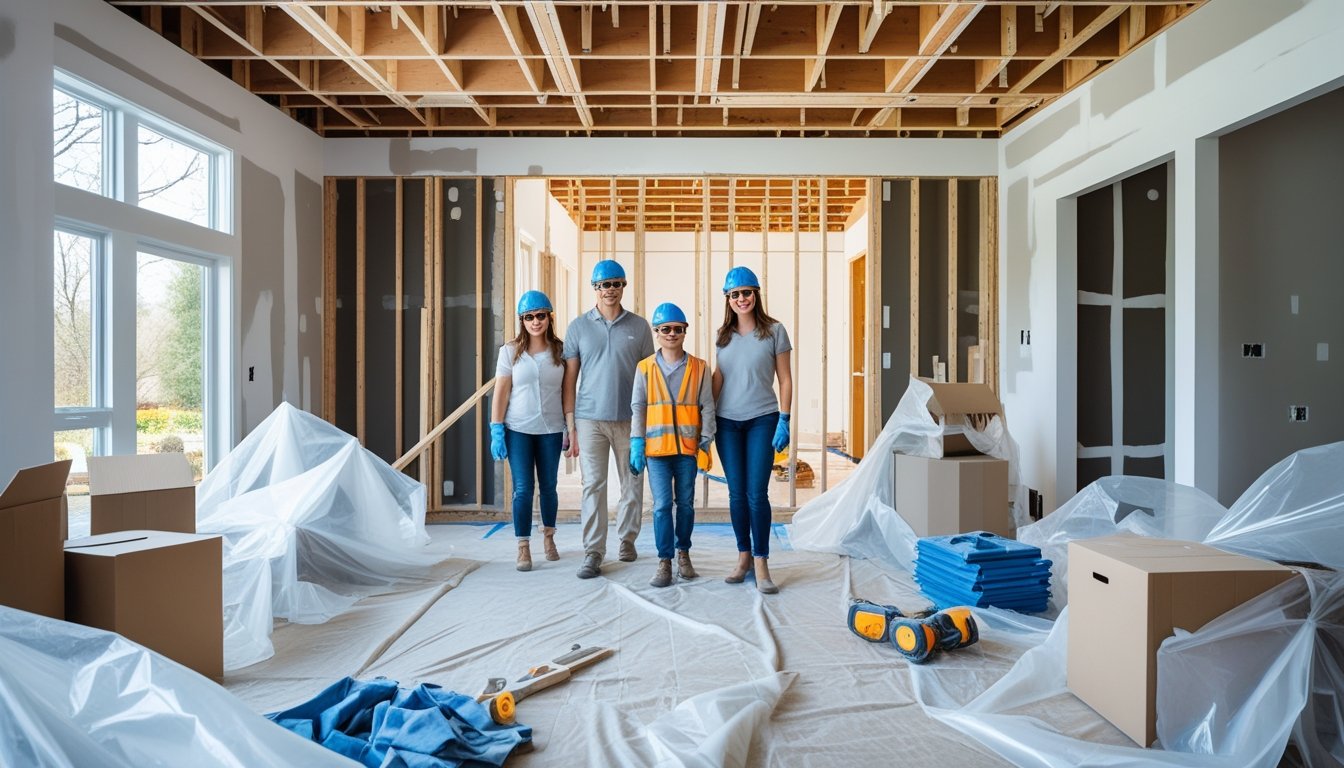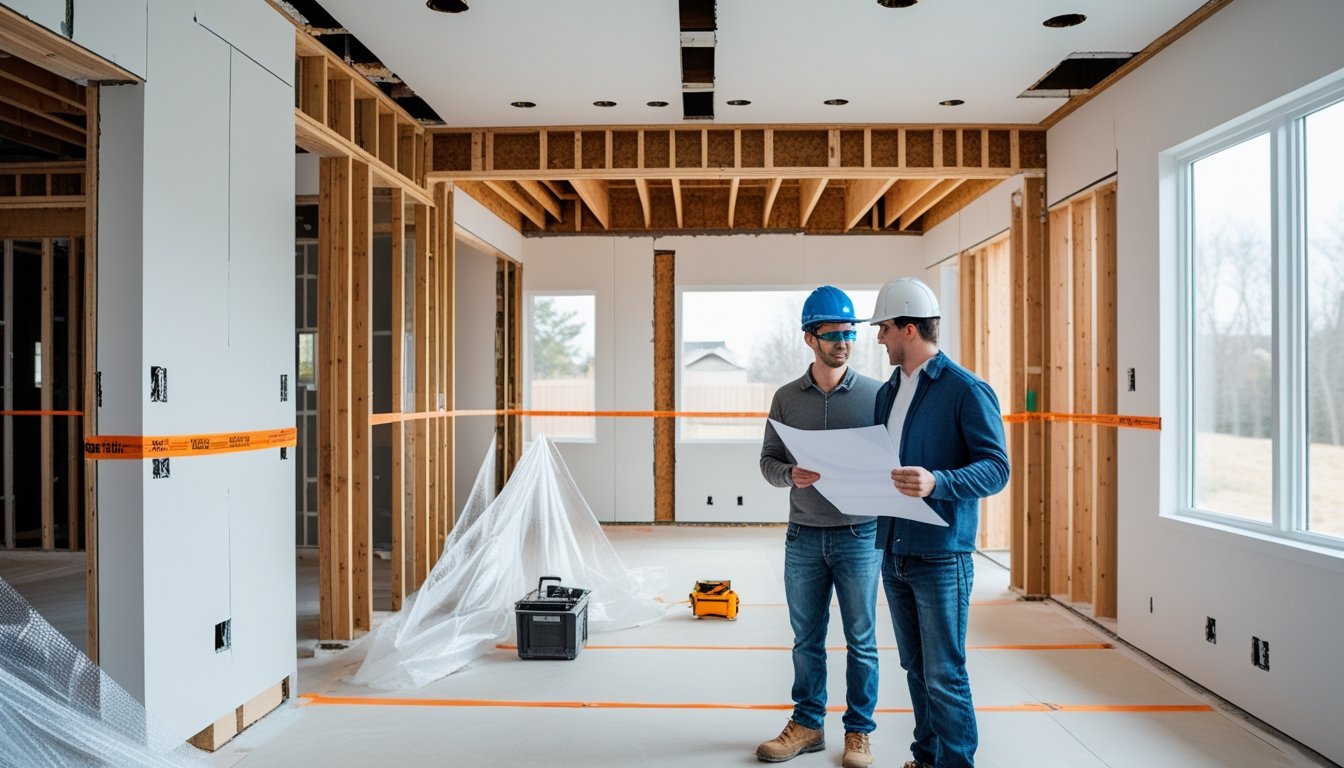Late updated: 14 Jul 2025 18:07
Written by: Elena Prescott
Safeguarding Your Home During Renovations: Essential Tips and Strategies
Renovating a home can be an exciting yet challenging venture that requires careful planning and consideration. As we embark on improvements, we must address essential safety concerns and strategies to protect our property and its occupants throughout the renovation process. Ensuring the safety of our home during renovations involves implementing measures like securing boundaries, protecting interiors, and maintaining a good ventilation system.

The dangers are not just limited to physical damage but can include intrusions and security threats. Renovations often mean increased traffic with contractors and workers, necessitating heightened vigilance. By anticipating these risks, we can minimise them effectively. It’s crucial to remain proactive, using the right protective materials and maintaining clear communication with all parties involved.
Within the dynamic environment of a home renovation, safeguarding the home from accidents and disruptions means monitoring every step closely. Organised preparation and awareness can make the difference, saving us from unnecessary stress and unexpected costs. Taking these steps allows us to focus on the exciting transformation of our space without unnecessary worry about its safety and integrity.
Key Takeaways
- Implement protective measures to ensure home safety during renovations.
- Be vigilant about security risks associated with increased traffic and changes.
- Use effective planning and resources to prevent damage and disruptions.
Key Strategies for Safeguarding Your Home During Renovations

Renovations can dramatically improve our living spaces, but they also require strategic protection to avoid damage. Preparing the renovation site, protecting interior areas, and ensuring proper safety measures are critical steps to safeguard our home effectively.
Site Preparation and Initial Home Assessment
Proper site preparation is crucial for maintaining the integrity of the rest of the home. We should start by assessing the current state of the house, identifying weak areas that may need additional support or protection. This could include examining walls, flooring, and existing furniture.
Using plastic sheeting to seal off construction areas can minimise dust and debris from spreading. Items in storage should be safely moved away, and fragile items must be stored in a secure location. It’s essential that we clearly define the boundaries of the renovation site, creating restricted zones and ensuring that all tools and materials are neatly organised to avoid accidents.
Protecting Interior Spaces: Surfaces and Furnishings
To maintain the condition of floors, walls, and furniture, employing robust protection methods is essential. Covering floors with cardboard or protective films can prevent scratches and damage from heavy equipment.
For additional safety measures, furniture should be covered with durable tarps or specialised covers to shield against dust and paint splatters. If space allows, moving small items to rooms not undergoing renovations is advisable. Walls vulnerable to damage can benefit from padded protection or corner guards, ensuring they remain unmarred during work.
Essential PPE for Homeowners and Workers
Safety isn't just about protecting the house; it’s also about safeguarding people. Personal Protective Equipment (PPE) is essential for both homeowners and any workers involved in the renovation.
We must ensure everyone has access to hard hats, gloves, and safety goggles. Non-slip footwear and dust masks are also critical in preventing accidents and safeguarding respiratory health. Having a basic first aid kit on hand helps us manage minor injuries swiftly.
Regular safety briefings and updates on new hazards ensure everyone stays informed and vigilant. In providing comprehensive PPE and training, we create a secure environment where renovations can proceed smoothly.
Minimising Risk and Preventing Damage Throughout the Renovation Process
During a renovation, protecting our home and belongings can be a challenging task. By adopting effective strategies, such as managing dust and debris, controlling moisture, and ensuring exterior protection, we can significantly reduce potential damage.
Managing Dust, Debris, and Containment Zones
Dust and debris are inevitable during renovations. Plastic sheeting can be invaluable in containing these elements to prevent them from spreading throughout our home. Creating containment zones with these sheets helps restrict dust to specific areas.
We should also employ air purifiers and vacuum systems with HEPA filters to trap fine particles. Ensuring daily clean-up and proper waste disposal minimises accumulation. Keeping personal protective equipment like masks handy ensures the safety of everyone involved in the renovation process.
Water Damage Prevention and Moisture Control
Water damage can be catastrophic if not managed correctly. Conducting an inspection to identify vulnerable areas, such as plumbing and roofs, is the first step. Using water-resistant materials and addressing any existing leaks can save us from future hassles.
Dehumidifiers play a crucial role in maintaining moisture levels, especially in enclosed areas. Keeping windows and doors sealed during damp weather is essential. Open communication with contractors about plumbing integrity can further safeguard against potential issues during the renovation project.
Ensuring Effective Exterior Protection
Our home's exterior is as important as the interior during renovations. Protecting walls, roofs, and windows from debris and the elements is vital. Using tarpaulins and scaffolding can shield these structures from damage.
We should also consider checking roof drainage systems to prevent water accumulation. Inspecting and reinforcing doors and windows are necessary steps to block wind or rain ingress. Proper scheduling and coordination with contractors ensure that the exterior finishing is done in favourable weather conditions, reducing the risk of damage.
Frequently Asked Questions
During home renovations, maintaining security and protecting valuables is essential. Implementing simple yet strategic measures can minimise dust and ensure privacy, while careful vetting of contractors helps safeguard property.
What measures can I take to ensure the security of my home while it's being renovated?
We recommend installing temporary security cameras and motion sensor lights. Securing entrances and using smart locks can further enhance safety. Communication with neighbours to keep an eye out can also be beneficial.
How do I protect my valuables from theft or damage during renovation works?
Storing valuables in a safe or offsite storage can minimise risks. We also suggest proper labelling of items and creating an inventory list to keep track of what’s inside the home during renovations.
Can you provide tips for minimising dust and debris in living spaces amidst construction?
To keep living areas clean, use plastic sheets to seal off construction zones. Air purifiers help capture dust particles, while frequent cleaning with a vacuum and damp cloth can maintain a healthy environment.
What precautions should I enforce with contractors to prevent accidental property damage?
It's important we communicate clear guidelines with contractors about protecting areas not under renovation. Protective coverings on flooring and furniture, along with detailed plans, can mitigate risks of damage.
How do I maintain my family's privacy and safety when workers have access to our home?
We suggest designating specific bathrooms for worker use and setting boundaries. Ensuring they work within designated hours can maintain privacy, and a buddy system if children are present can increase safety.
What are the best practices for vetting and overseeing tradespeople to safeguard my property during their work?
Before hiring, we should verify references, insurance, and credentials. Regular check-ins and a clear contract outlining job specifics can assure accountability and professional behaviour. Open communication remains key to a smooth process.
